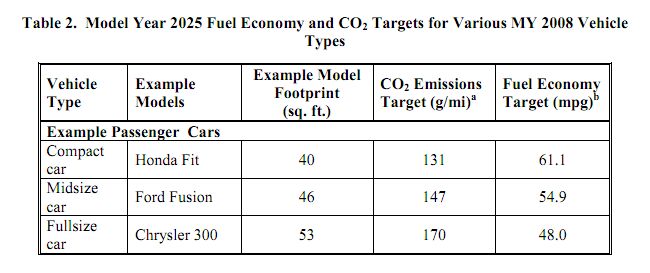EPA Releases 2017-2025 CAFE Proposed Rule
Over the last few days we’ve been discussing the implications of the growing gap between global oil demand and production, looking at the responses of a global automaker, a radical startup and the oil industry itself. And make no mistake, it’s an uncertain future out there… unless you’re selling cars in the US. In that case, your future just arrived, planned all the way through 2025. That is, if you think this proposed rule will survive four presidential elections and one industry-government “mid-term review.” Want to familiarize yourself with this pre-planned fuel economy future? All 893 pages await your perusal, in PDF format here. Or, hit the jump for a few broad strokes.
So, what does this mean for specific classes of cars? According to an EPA factsheet ( PDF here), this is how cars in the year 2025 will have to perform:
How about trucks?
Now that may seems scary, but you have to remember that these numbers are not comparable to the EPA’s “window sticker” numbers. For inexplicable reasons, probably having to do with the political benefits to both industry and politicians of making the number seem higher than it is, NHTSA’s CAFE fuel economy uses a different test than the EPA. Edmunds Autoobserver covered this issue well a few years back, but the upshot is that a 2025 full-size pickup will be required to get a window sticker of around 25 MPG combined, not 33 MPG. Still tough, but considering that full-sizers are getting over 20 MPG on the freeway already, this does not seem like a hill that can’t be climbed in a decade or so. Especially when you can slap a hybrid drivetrain in there and get a 20 grams of CO2 per mile credit.
Of course these standards will cost consumers. The EPA estimates that the proposed rule will add some $2,000 to the price of each vehicle on average, but insists
Those consumers who drive their MY 2025 vehicle for its entire lifetime will save, on average, $5200 to $66003 (7 and 3 percent discount rates, respectively) in fuel savings, for a net lifetime savings of $3000 to 44004 — assuming gasoline prices remain at essentially current levels. For those consumers who purchase their new MY 2025 vehicle with cash, the discounted fuel savings will offset the higher vehicle cost in less than 4 years, and fuel savings will continue for as long as the consumer owns the vehicle.
Of course if gas prices aren’t kind enough to “remain at essentially current levels,” those fuel savings could be wiped out… but then, if gas prices rise too precipitously, this entire rule could become moot. The future is notoriously resistant to our mortal plans…
More by Edward Niedermeyer
Latest Car Reviews
Read moreLatest Product Reviews
Read moreRecent Comments
- Hari Your route home sounds like the perfect stretch for a car like the Alfa Romeo Giulia. Its renowned handling and dynamic performance make it an ideal match for those curves. For enthusiasts or potential owners interested in understanding all the capabilities of the Giulia 2017, the owner’s manual is an invaluable resource. Check it out here: https://chatwithmanuals.com/automobiles/2017-alfa-romeo-giulia-owners-manual/. Our AI-powered chat makes navigating the manual simple, helping you quickly find specific details about the car's features and specs. Perfect for making the most out of those driving moments and truly understanding your vehicle!
- Dale I'd consider the RAV4 if the Prime were on the table as paying for gas is for suckers. Otherwise, we have a couple of Mazdas and they are swell. I've driven older versions of both and the CX-5 is a nicer place to live.
- Haran Spot-on review of the Mercedes-AMG GT’s price adjustments and new features! For those intrigued by the all-wheel drive and enhanced features of the latest model, you can delve deeper with the complete operator's manual available here: https://chatwithmanuals.com/automobiles/mercedes-amg-gt-operators-manual-edition-c2020/. It’s a fantastic resource for understanding all the specs and new additions without getting bogged down by the complexity typically associated with car manuals. Chat with the manual using AI to quickly find exactly what you need to know about this sporty beast. Perfect for those who appreciate detailed insights on their luxury investments!
- Flashindapan Beautiful color combinations. I assumed they stop selling the TT here at least five or six years ago.
- Carson D Just don't be the whistleblower who reports on the falsification of safety data. That's a deadly profession.




































Comments
Join the conversation
So with the references to g/mi and MPG in 2025, it looks like the EPA is assuming that no matter who the president is, no president will have the balls to continue with full metrication in the US? (We don't need none of them commie base 10 units of measure!) Anyway, I sure hope this means more diesel options. But of course when the EPA has their say, clean diesel just means more expensive emission components to break and lower economy. I'm sure the manufacturers will figure out ways to do it, but it'll be interesting to see how they manage to do it. That is if any of these numbers are actually the same in 2025.
I don't know how you consider tough, but here are the numbers the way I see them. The best non-hybrid full size truck combined MPG is 19mpg. That is the V6 Ford F150 3.7L. Best V8, GM 5.3 XFE with 18mpg combined. 19mpg to 25mpg is a minimal of 32% overall improvement. 18mpg to 25mpg is a 39% improvement. My guess is that trucks are going to become a lot less capable in the next 10 years, be made of different materials, and all have hybrid technology. Will be interesting to see how much they cost, weigh, and tow in 10 years.